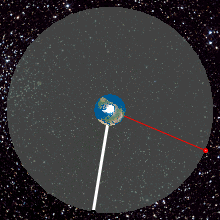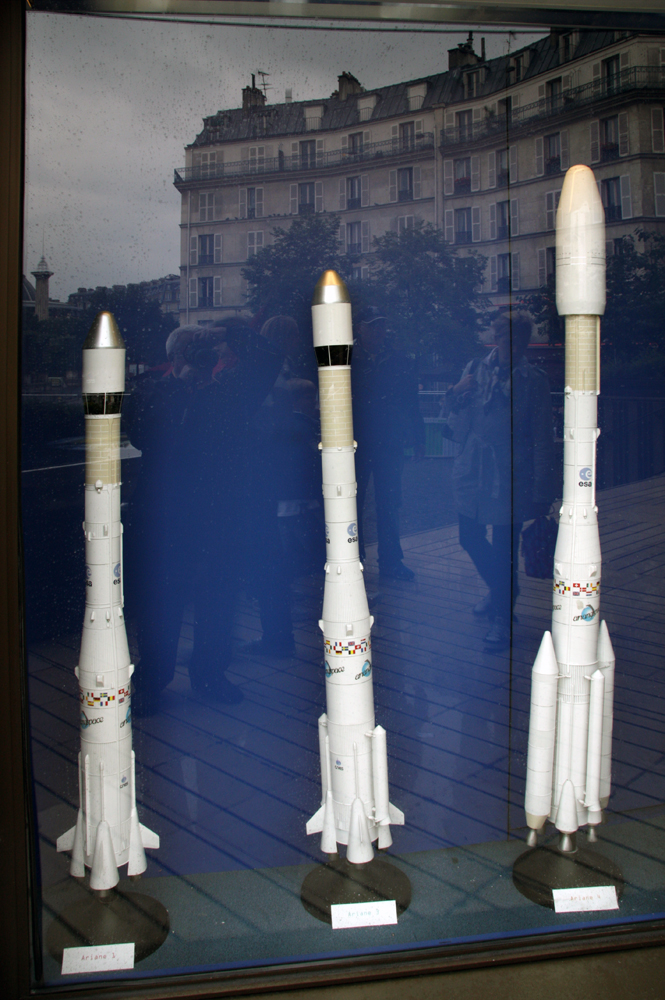|
Eutelsat Konnect
Eutelsat Konnect is a geostationary communications satellite operated by Eutelsat. The satellite was designed and manufactured by Thales Alenia Space on the Spacebus NEO 100 platform, and was launched on 16 January 2020 on an Ariane 5 ECA. The satellite provides broadband internet and communications coverage to Europe and Sub-Saharan Africa. History In October 2015, Eutelsat ordered a next-generation communications satellite originally named the African Broadband Satellite. The satellite was ordered as part of Eutelsat's move to expand in the African communications market. Thales Alenia Space contracted launch on an Ariane 5 ECA, co-manifested with another payload as is usual, GSAT-30. Spacecraft Eutelsat Konnect is built on the Spacebus NEO 100 platform, an all-electric satellite bus designed with funding and support from the European Space Agency (ESA) and French agency, CNES. In addition to providing more communications capacity, the new platform provided significant ma ... [...More Info...] [...Related Items...] OR: [Wikipedia] [Google] [Baidu] |
Communications Satellite
A communications satellite is an artificial satellite that relays and amplifies radio telecommunication signals via a Transponder (satellite communications), transponder; it creates a communication channel between a source transmitter and a Radio receiver, receiver at different locations on Earth. Communications satellites are used for television, telephone, radio, internet, and military applications. Many communications satellites are in geostationary orbit above the equator, so that the satellite appears stationary at the same point in the sky; therefore the satellite dish antennas of ground stations can be aimed permanently at that spot and do not have to move to track the satellite. Others form satellite constellations in low Earth orbit, where antennas on the ground have to follow the position of the satellites and switch between satellites frequently. The radio waves used for telecommunications links travel by Line-of-sight propagation, line of sight and so are obstructe ... [...More Info...] [...Related Items...] OR: [Wikipedia] [Google] [Baidu] |
Spacecraft Launched In 2020
A spacecraft is a vehicle that is designed spaceflight, to fly and operate in outer space. Spacecraft are used for a variety of purposes, including Telecommunications, communications, Earth observation satellite, Earth observation, Weather satellite, meteorology, navigation, space colonization, Planetary science, planetary exploration, and Space transport, transportation of Human spaceflight, humans and cargo spacecraft, cargo. All spacecraft except single-stage-to-orbit vehicles cannot get into space on their own, and require a launch vehicle (carrier rocket). On a sub-orbital spaceflight, a space vehicle enters space and then returns to the surface without having gained sufficient energy or velocity to make a full Geocentric orbit, Earth orbit. For orbital spaceflights, spacecraft enter closed orbits around the Earth or around other Astronomical object, celestial bodies. Spacecraft used for human spaceflight carry people on board as crew or passengers from start or on orbit ... [...More Info...] [...Related Items...] OR: [Wikipedia] [Google] [Baidu] |
Communications Satellites In Geostationary Orbit
Communication is commonly defined as the transmission of information. Its precise definition is disputed and there are disagreements about whether unintentional or failed transmissions are included and whether communication not only transmits meaning but also creates it. Models of communication are simplified overviews of its main components and their interactions. Many models include the idea that a source uses a coding system to express information in the form of a message. The message is sent through a channel to a receiver who has to decode it to understand it. The main field of inquiry investigating communication is called communication studies. A common way to classify communication is by whether information is exchanged between humans, members of other species, or non-living entities such as computers. For human communication, a central contrast is between verbal and non-verbal communication. Verbal communication involves the exchange of messages in linguistic form ... [...More Info...] [...Related Items...] OR: [Wikipedia] [Google] [Baidu] |
Geostationary Transfer Orbit
In space mission design, a geostationary transfer orbit (GTO) or geosynchronous transfer orbit is a highly elliptical type of geocentric orbit, usually with a perigee as low as low Earth orbit (LEO) and an apogee as high as geostationary orbit (GEO). Satellites that are destined for geosynchronous orbit (GSO) or GEO are often put into a GTO as an intermediate step for reaching their final orbit. Larson, Wiley J. and James R. Wertz, eds. Space Mission Design and Analysis, 2nd Edition. Published jointly by Microcosm, Inc. (Torrance, CA) and Kluwer Academic Publishers (Dordrecht/Boston/London). 1991. Manufacturers of launch vehicles often advertise the amount of payload the vehicle can put into GTO. Background Geostationary and geosynchronous orbits are very desirable for many communication and Earth observation satellites. However, the delta-v, and therefore financial, cost to send a spacecraft to such orbits is very high due to their high orbital radius. A GTO is an intermedia ... [...More Info...] [...Related Items...] OR: [Wikipedia] [Google] [Baidu] |
Indian Space Research Organisation
The Indian Space Research Organisation (ISRO ) is India's national List of government space agencies, space agency, headquartered in Bengaluru, Karnataka. It serves as the principal research and development arm of the Department of Space (DoS), overseen by the Prime Minister of India, with the Chairperson of the Indian Space Research Organisation, Chairman of ISRO also serving as the chief executive of the DoS. It is primarily responsible for space-based operations, space exploration, international space cooperation and the development of related technologies. The agency maintains a constellation of Earth observation satellite, imaging, Communications satellite, communications and remote sensing satellites. It operates the GPS-aided GEO augmented navigation, GAGAN and Indian Regional Navigation Satellite System, IRNSS satellite navigation systems. It has sent Chandrayaan programme, three missions to the Moon and Mars Orbiter Mission, one mission to Mars. Formerly known as the In ... [...More Info...] [...Related Items...] OR: [Wikipedia] [Google] [Baidu] |
Spot Beam
A spot beam, in telecommunications parlance, is a satellite signal that is specially concentrated in power (i.e. sent by a high-gain antenna) so that it will cover only a limited geographic area on Earth. Spot beams are used so that only Earth stations in a particular intended reception area can properly receive the satellite signal. One notable example of the use of spot beams is on direct broadcast satellite systems such as DirecTV and Dish Network that deliver local broadcast television via satellite only to viewers in the part of North America North America is a continent in the Northern Hemisphere, Northern and Western Hemisphere, Western hemispheres. North America is bordered to the north by the Arctic Ocean, to the east by the Atlantic Ocean, to the southeast by South Ameri ... from which those terrestrial broadcast stations originate. Spot beams allow satellites to transmit different data signals using the same frequency. Because satellites have a limited number ... [...More Info...] [...Related Items...] OR: [Wikipedia] [Google] [Baidu] |
Gbps
In telecommunications, data transfer rate is the average number of bits (bitrate), characters or symbols (baudrate), or data blocks per unit time passing through a communication link in a data-transmission system. Common data rate units are multiples of bits per second (bit/s) and bytes per second (B/s). For example, the data rates of modern residential high-speed Internet connections are commonly expressed in megabits per second (Mbit/s). Standards for unit symbols and prefixes Unit symbol The ISQ symbols for the bit and byte are ''bit'' and ''B'', respectively. In the context of data-rate units, one byte consists of 8 bits, and is synonymous with the unit octet. The abbreviation bps is often used to mean bit/s, so that when a ''1 Mbps'' connection is advertised, it usually means that the maximum achievable bandwidth is 1 Mbit/s (one million bits per second), which is 0.125 MB/s (megabyte per second), or about 0.1192 MiB/s ( mebibyte per second). The I ... [...More Info...] [...Related Items...] OR: [Wikipedia] [Google] [Baidu] |
Geostationary Satellites
A geostationary orbit, also referred to as a geosynchronous equatorial orbit''Geostationary orbit'' and ''Geosynchronous (equatorial) orbit'' are used somewhat interchangeably in sources. (GEO), is a circular geosynchronous orbit in altitude above Earth's equator, in radius from Earth's center, and following the direction of Earth's rotation. An object in such an orbit has an orbital period equal to Earth's rotational period, one sidereal day, and so to ground observers it appears motionless, in a fixed position in the sky. The concept of a geostationary orbit was popularised by the science fiction writer Arthur C. Clarke in the 1940s as a way to revolutionise telecommunications, and the first satellite to be placed in this kind of orbit was launched in 1963. Communications satellites are often placed in a geostationary orbit so that Earth-based satellite antennas do not have to rotate to track them but can be pointed permanently at the position in the sky where the sate ... [...More Info...] [...Related Items...] OR: [Wikipedia] [Google] [Baidu] |
CNES
CNES () is the French national space agency. Headquartered in central Paris, the agency is overseen by the ministries of the Armed Forces, Economy and Finance and Higher Education, Research and Innovation. It operates from the Toulouse Space Centre and the Guiana Space Centre. The president of CNES is Philippe Baptiste. CNES is a member of Institute of Space, its Applications and Technologies. It is Europe's largest national organization of its type. History CNES was established under President Charles de Gaulle in 1961. It is the world's third oldest space agency, after the Soviet space program (Russia), and NASA (United States). CNES was responsible for the training of French astronauts, until the last active CNES astronauts transferred to the European Space Agency in 2001. , CNES is working with Germany and a few other governments to start a modest research effort with the hope to propose a LOX/methane reusable launch vehicle by mid-2015. If built, flight testing w ... [...More Info...] [...Related Items...] OR: [Wikipedia] [Google] [Baidu] |
European Space Agency
The European Space Agency (ESA) is a 23-member International organization, international organization devoted to space exploration. With its headquarters in Paris and a staff of around 2,547 people globally as of 2023, ESA was founded in 1975 in the context of European integration. Its 2025 annual budget was €7.7 billion. The ESA Human and Robotic Exploration programme includes human spaceflight (mainly through participation in the International Space Station programme); as well as the launch and operation of missions to Mars and Moon. Further activities include science missions to Jupiter, Mercury, the Sun, Earth observation, Asteroid impact avoidance and Telecommunications missions, designing launch vehicles; and maintaining Europe's Spaceport, the Guiana Space Centre at Kourou (French Guiana). Further programmes include space safety, satellite navigation, applications and commercialisation. The main European launch vehicle Ariane 6 is operated through Arianespace ... [...More Info...] [...Related Items...] OR: [Wikipedia] [Google] [Baidu] |
GSAT-30
GSAT-30 is a telecommunications satellite developed by the Indian Space Research Organisation (ISRO). Mission The satellite's main communication payload is 12 Ku band, Ku band transponders for covering Indian mainland and islands and 12 C band (IEEE), C-band Transponder (satellite communications), transponders for extended coverage over Asia and Australia. The satellite will act as a replacement for the defunct INSAT-4A. The satellite provides advanced telecommunication services to the Indian subcontinent. It is used for Very-small-aperture terminal (VSAT) networks, television uplinks, Electronic news-gathering, digital satellite news gathering, Direct-broadcast satellite (DTH) services and other communication systems. This is the 41st communication satellite launched by ISRO and the 24th launch of ISRO satellite by Arianespace. Satellite The satellite is based on ISRO's I-3K bus. It was assembled by a consortium of mid-sized industries led by Alpha Design Technologies Ltd. ... [...More Info...] [...Related Items...] OR: [Wikipedia] [Google] [Baidu] |




